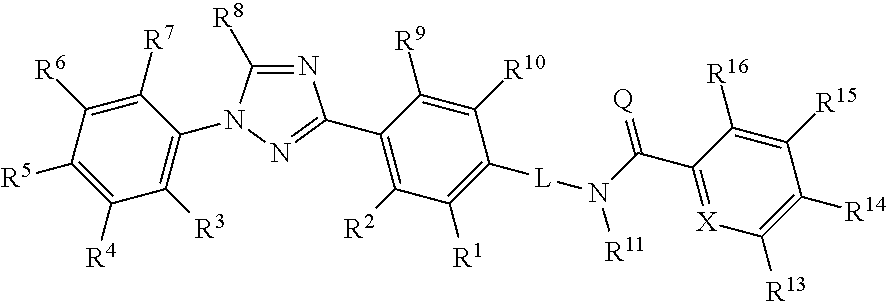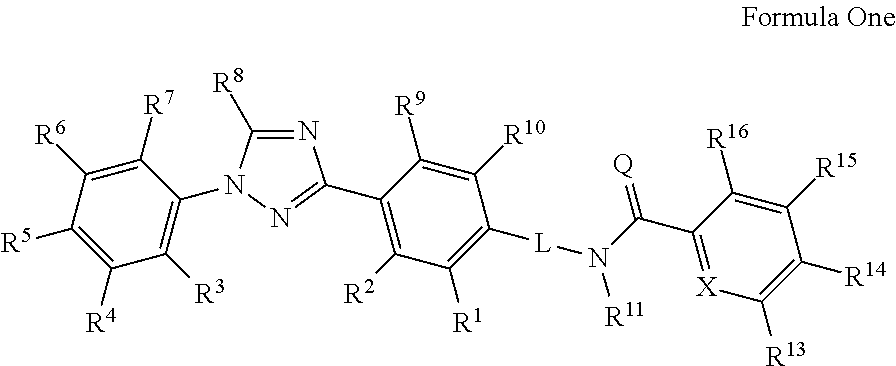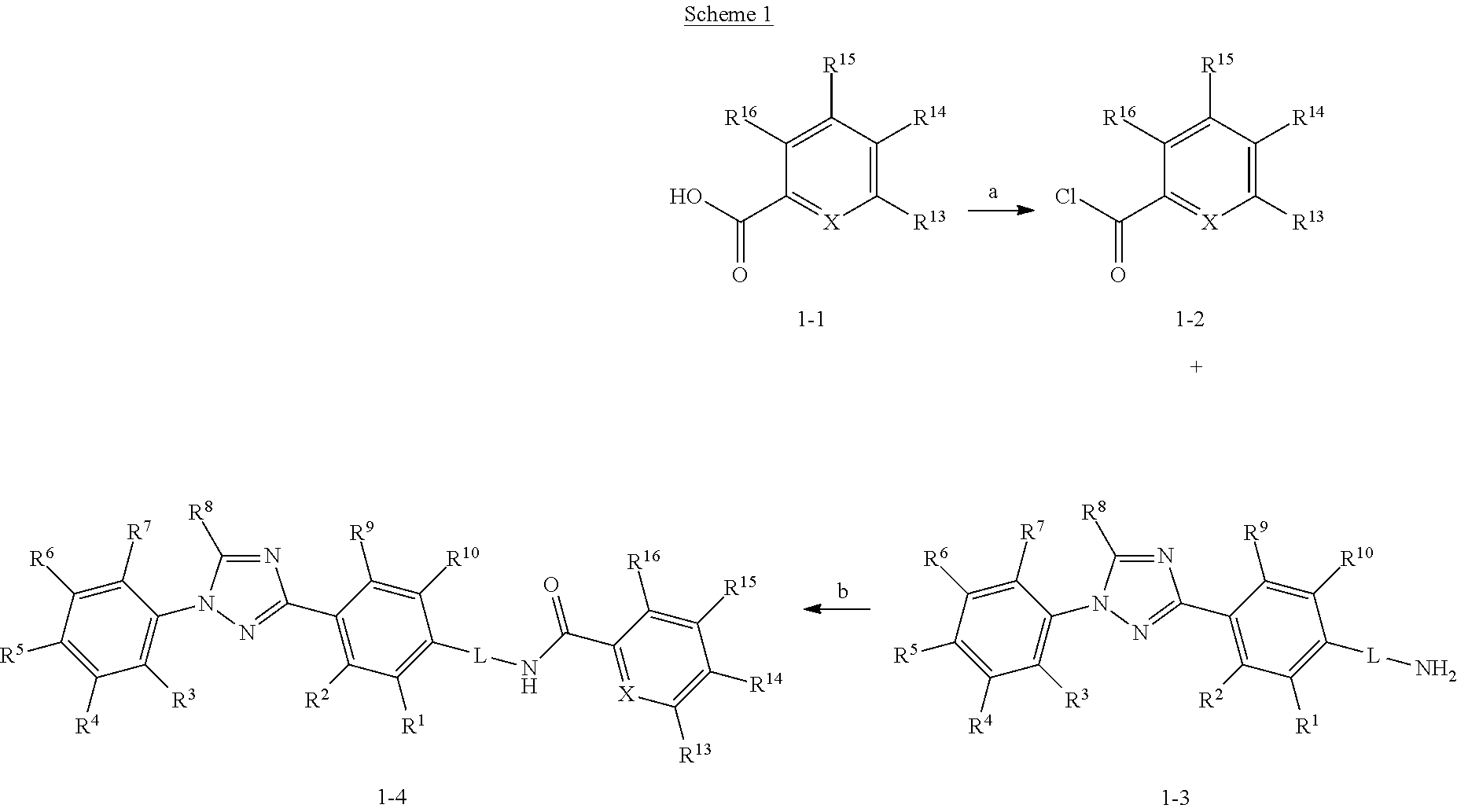Molecules having certain pesticidal utilities, and intermediates, compositions, and processes related thereto
a technology of pesticidal utilities and molecules, applied in the field of molecules, can solve the problems of weeds destroying more than 40% of all potential food production, affecting the quality of food, and often one of the most insidious and costly problems
- Summary
- Abstract
- Description
- Claims
- Application Information
AI Technical Summary
Benefits of technology
Problems solved by technology
Method used
Image
Examples
example 1
Preparation of 3-bromo-1-(4-isopropoxyphenyl)-1H-1,2,4-triazole
[0096]
[0097]3-bromo-1H-1,2,4-triazole (1.75 g, 11.8 mmol), copper(I) iodide (0.370 g, 1.94 mmol), cesium carbonate (4.98 g, 15.3 mmol), and 1-iodo-4-isopropoxybenzene (2.04 g, 7.78 mmol) (Katsumatu, T., et al. Macromolecular Chemistry and Physics, 2009, 210 (22), 1891-1902) was placed in dimethylsulfoxide (50 mL) and degassed with nitrogen for 10 minutes. The solution was heated at 100° C. for 20 hours. After cooling to room temperature, the reaction mixture was diluted with ethyl acetate and filtered through Celite®. The resulting filter cake was rinsed with additional ethyl acetate (100 mL). The filtrate was washed with water (2×50 mL). The combined aqueous washes were neutralized with hydrochloric acid (2 N) as measured by pH paper. The aqueous solution was extracted with ethyl acetate (2×30 mL) and the organic extracts were combined, and then dried over anhydrous magnesium sulfate. The organic solution was concentrat...
example 2
Preparation of 4-(1-(4-isopropoxyphenyl)-1H-1,2,4-triazol-3-yl)aniline (C2)
[0098]
[0099]Placed 3-bromo-1-(4-isopropoxyphenyl)-1H-1,2,4-triazole (C1) (0.540 g, 1.91 mmol), 4-(4,4,5,5-tetramethyl-1,3,2-dioxaborolan-2-yl)aniline (0.510 g, 2.32 mmol), tetrakis(triphenylphosphine) palladium(0) (0.240 g, 0.210 mmol), and potassium carbonate (2.65 g, 19.2 mmol) in 1,2-dimethoxyethane (8 mL) and water (2 mL) and degassed the mixture with nitrogen for 10 minutes. The solution was heated at 120° C. for 15 hours. The solution was cooled to room temperature and diluted the mixture with ethyl acetate (5 mL). The resultant salts were filtered and the layers were separated. The aqueous layers were extracted with ethyl acetate (2×5 mL). The combined organic layers were dried over anhydrous magnesium sulfate and concentrated onto Celite®. Purification by silica gel chromatography using 0-100% ethyl acetate / hexanes as eluent provided the title compound as a tan solid (0.430 g, 73%): 1H NMR (400 MHz, C...
example 3
Preparation of N-(4-(1-(4-isopropoxyphenyl)-1H-1,2,4-triazol-3-yl)phenyl)-2′-methoxy-[1,1′-biphenyl]-3-carboxamide (F5)
[0100]
[0101]To a mixture of 2′-methoxy-[1,1′-biphenyl]-3-carboxylic acid (0.140 g, 0.610 mmol) in dichloromethane (5 mL) was added oxalyl chloride (0.150 mL, 1.75 mmol) and dimethylformamide (2 drops). After stirring for 3 hours at room temperature, the reaction was concentrated to dryness. The resulting yellow oil was dissolved in anhydrous tetrahydrofuran (2 mL) and added to a solution of 4-(1-(4-isopropoxyphenyl)-1H-1,2,4-triazol-3-yl)aniline (C2) (0.134 g, 0.460 mmol) dissolved in tetrahydrofuran (3 mL) and diisopropylethylamine (0.190 mL, 1.09 mmol) and stirred at room temperature for 18 hours. The solution was diluted with ethyl acetate (10 mL) and washed with saturated aqueous sodium bicarbonate. The aqueous wash was extracted with ethyl acetate (2×5 mL) and the combined organic layers were dried over anhydrous magnesium sulfate. The solution was concentrate...
PUM
| Property | Measurement | Unit |
|---|---|---|
| Fraction | aaaaa | aaaaa |
Abstract
Description
Claims
Application Information
 Login to View More
Login to View More - R&D
- Intellectual Property
- Life Sciences
- Materials
- Tech Scout
- Unparalleled Data Quality
- Higher Quality Content
- 60% Fewer Hallucinations
Browse by: Latest US Patents, China's latest patents, Technical Efficacy Thesaurus, Application Domain, Technology Topic, Popular Technical Reports.
© 2025 PatSnap. All rights reserved.Legal|Privacy policy|Modern Slavery Act Transparency Statement|Sitemap|About US| Contact US: help@patsnap.com



